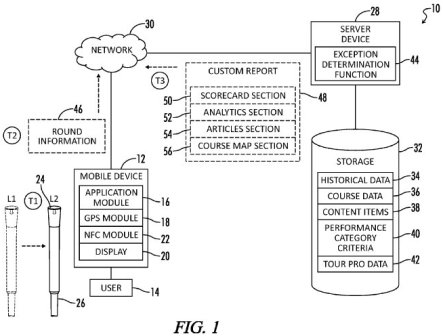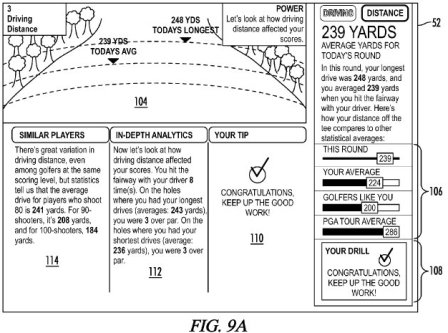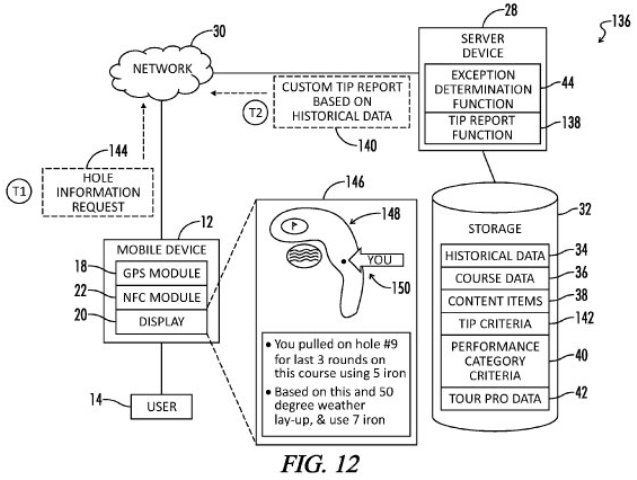Matty G the Inventor! Say What
Last week a patent application caught my eye because it listed the Golf Channel’s Matt Ginella as an inventor. Yes sir, Matty G played a part in the invention titled “Determination of Custom Information Based on Golfer Performance Data.”

What’s next, a training aid designed by Damon Hack, a line of cotton tank tops designed by Gary Williams, or maybe a vegan cookbook authored by Charlie Rymer?
The patent application published as US Pub. No. 20140094942, which describes the invention as:
The present embodiments relate to the determination of custom information based on golfer performance data. In one embodiment, a device receives round information that identifies a round of golf of a user. Based at least in part on the round information, at least one performance category exception based on a performance category criterion is determined. At least one content item from a plurality of content items is selected based on the at least one performance category exception. A custom report is generated that identifies the at least one performance category exception and includes the at least one content item.
The application goes on to explain:
BACKGROUND
[0003] Many players of a sport are interested in improving their performance in the sport. Players may take lessons and may practice a substantial amount of time in pursuit of improved performance. The performance of a player in certain sports, such as golf, not only depends in part on a highly complicated motion, such as swinging a golf club, but on myriad other factors that may differ on a shot-by-shot basis, such as lie, wind, obstacles and the like, all of which should be taken into consideration when hitting a particular shot.
[0004] Many deficiencies of golfers may be identifiable only with knowledge of past performance. For example, a golfer may not realize that their chipping is particularly poor compared to other types of shots, and may not seek out advice on techniques for improving chipping performance. Many golfers play the same courses repeatedly, and may not realize that certain holes cause the golfer more problems than other holes.
[0005] It is impractical for most golfers while playing multiple rounds of golf to take meticulous notes that may shed light on his particular deficiencies, or on which aspects of a particular golf course are more problematic than others.
[0006] Accordingly, there is a need for mechanisms that at least in part automate the generation of information that describes a golfer’s performance on a golf course, and the subsequent analysis and use thereof to provide custom information to the golfer to aid the golfer in improving in the sport.
SUMMARY
[0007] The present embodiments relate to the collection of golfer performance data, and the analysis thereof to provide custom information to a user based on the golfer performance data.
[0008] In one embodiment, a device receives round information that identifies a round of golf of the user. Based at least in part on the round information, at least one performance category exception is determined based on a performance category criterion. At least one content item is selected from a plurality of content items based on the at least one performance category exception. The plurality of content items comprises articles that provide advice relating to one or more of the golf performance categories. A custom report is generated that identifies the at least one performance category exception and includes the at least one content item. In one embodiment, the round information is collected substantially in real-time, either as the round of golf is played, or immediately thereafter. The custom report may then be generated substantially instantaneously, and provided to the user immediately following the conclusion of the round of golf.
[0009] In one embodiment, the round information includes a plurality of hole datasets, each of which corresponds to a different hole of the holes played in the round of golf. Each hole dataset may comprise a plurality of shot datasets, each shot dataset corresponding to a particular host played in the corresponding hole. Each shot dataset may identify, for example, a club identifier that identifies the club used for the respective shot, and distance information that identifies a distance a golf ball travelled when struck by the club.
[0010] In one embodiment, the performance category criterion is based on a total score of the round of the user and a model performance function. An actual performance value based on the model performance function and the total score is calculated. The at least one performance category exception is determined based on the actual performance value.
[0011] In another embodiment, the performance category criterion is based on an historical performance of the user in a performance category associated with the performance category criterion. Historical data that identifies the historical performance of the user in the performance category is accessed. A current performance of the user in the performance category during the round is compared to the historical performance. The at least one performance category exception is determined based on the comparison. In some embodiments, a performance category exception may be determined based on any one of a plurality of different performance category criteria.
[0012] The historical data may comprise data identifying previous performances of the user at the same golf course at which the current round is being played.
[0013] In one embodiment, based at least in part on the round information, a set of performance category exceptions may be determined. Each performance category exception corresponds to a different performance category. For each respective performance category exception in the set, at least one content item that provides advice relating to the corresponding performance category is selected. A priority for performance category exceptions in the set is determined. The custom report includes the at least one content item for each respective performance category in order of the priority.
[0014] In another embodiment, a tip report based on historical performance is provided. It is determined that the user is playing a hole on a golf course. Historical data that identifies a previous performance of the user is accessed. Based on the historical data, it is determined that a tip criterion has been met. Based on the tip criterion, a tip report for the user is generated.
[0015] In one embodiment, it is determined that the user is playing the hole on the golf course in response to receiving, from the user, a request for information about the hole. In anothe
r embodiment, it is determined that the user is playing the hole on the golf course by determining the location of the user, accessing golf course data, and determining, based on the location of the user and the golf course, data that the user is playing the hole.[0016] In one embodiment, the previous performance comprises a previous performance of the user on the hole. In another embodiment, the previous performance comprises a previous performance of the user during the current round of golf.
Here are some of the drawings from the application:





Matty G – where are the tips about avoiding the shanks?
David Dawsey – Keeping an Eye on Golf Inventions
PS – If you like what we are doing, please considering helping us out and make your online gear purchases through our Amazon affiliate link. Every little purchase helps us keep the site up and running! Thanks.
